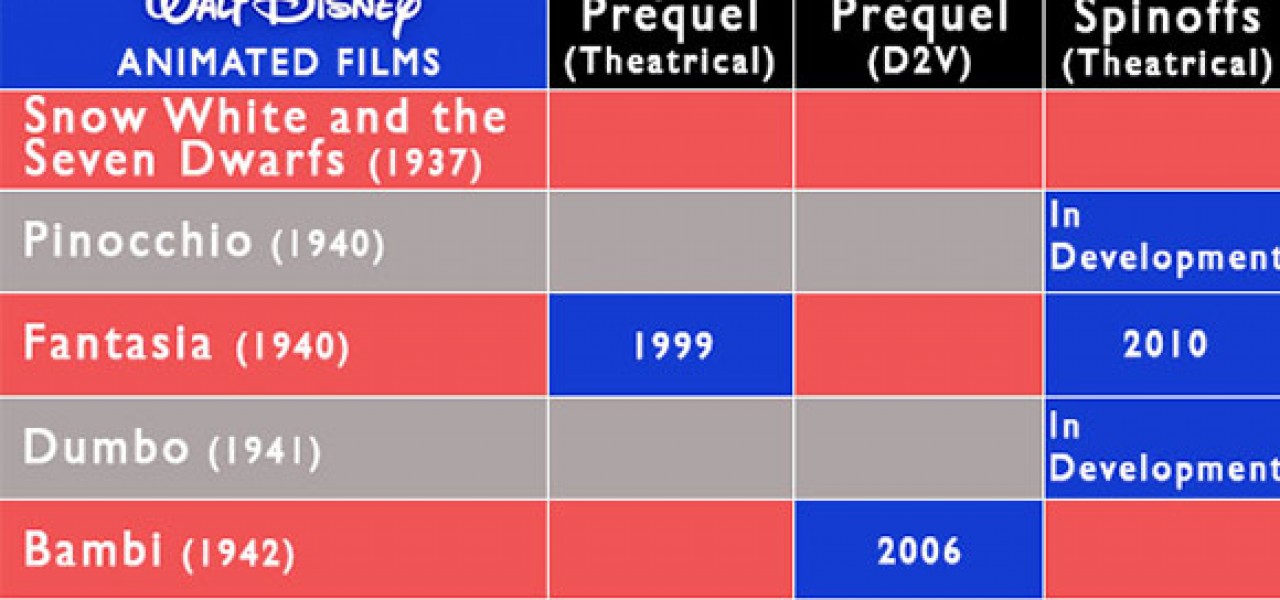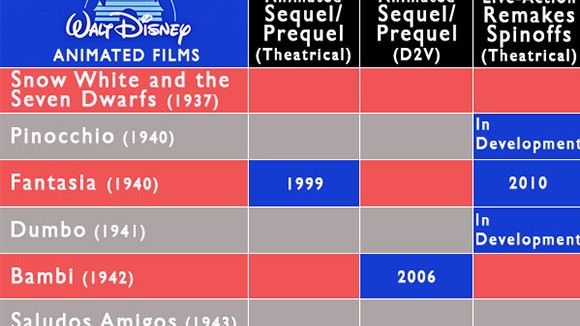

Chart: A Guide to Every Disney Animation Sequel, Remake & Spinoff

Earlier this week, Disney announced that it was developing Genies, a live-action spin-off of its 1992 animated feature Aladdin.
Each time Disney announces a live-action remake of one of its well-known animated films — and they’ve done it plenty in the past few years — the online community greets the news with a mix of excitement, consternation, and incredulity. But sequels, prequels, remakes, and spin-offs aren’t simply an extra source of income for Disney; they are the foundation of Disney’s “brands and franchises” strategy, which accounts for a significant chunk of the studio’s revenue. Continually replenishing its animated properties also feeds into the company’s other profit centers like licensing, merchandising, and theme parks.
 SEE ALSO: The Secret to Disney’s Record Profits Can Be Summed Up In Just One Word
SEE ALSO: The Secret to Disney’s Record Profits Can Be Summed Up In Just One Word
Cartoon Brew created the chart below, which we plan to update periodically, to document how Disney uses its established animated features as a springboard for sequels, spin-offs, remakes, and series. While this chart specifically focuses on the studio’s own theatrical animated features, the same strategy is applied across all Disney-owned brands, including Pixar, Lucasfilm, and Marvel.
The Internet might want to scan this chart first and take a deep breath before getting too incredulous about the perhaps inevitable live-action reboot of Bambi.

This macro-level view of Disney’s approach to animation franchises led to these observations:
* In the Michael Eisner era, Disney rarely touched its core classics from Snow White and the Seven Dwarfs (1937) through Sleeping Beauty (1959). In that time, just four projects–Fantasia 2000, Cinderella II: Dreams Come True, Lady and the Tramp II: Scamp’s Adventure and Return to Never Land–were produced based on the studio’s first sixteen entertainment features. Since Bob Iger took over as CEO in 2005, sixteen new projects have either been released (or are currently in development) based on that same set of films.
* The studio’s shift to live-action remakes and spin-offs of animated films coincides with the collapse of the home video market in the late-2000s. The studio’s last animated direct-to-video sequel/prequel/midquel was 2008’s The Little Mermaid: Ariel’s Beginning.
* Just one sequel/spinoff/series emerged from the seven films between Treasure Planet (2002) and The Princess and the Frog (2009). Prior to those films, the company had been aggressive about using its original theatricals as springboards. It was during this creative drought that Disney became more open to resurrecting classic IP. The lack of new projects derived from its theatrical releases during this period stresses the importance of continually creating original content that resonates with audiences, while the studio’s vast collection of classics allows it to weather periods of creative struggle.
* Even with all the sequels and remakes, the studio has numerous properties that it hasn’t touched at all, including most of their films from the mid-to-late-1940s, as well as later projects like Sword in the Stone, Aristocats, Robin Hood, The Great Mouse Detective, and Oliver and Company, among others. With the studio now remaking its 1977 live-action/animated hybrid Pete’s Dragon, other less-visible animated films could be next in line for revivals, too.

